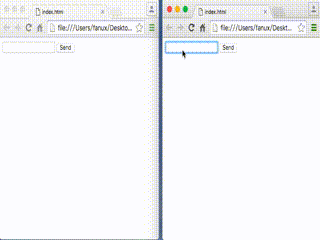好用的websocket框架推荐
描述
Lhttp是一个基于websocket服务端框架,提供一个类似http的协议去帮助开发者开发长连接的应用。
使用Lhttp可以大量减少服务端开发的工作量,实现非常好的模块化和业务功能的解耦合。
可以定制任何你想要的功能。
项目地址
特点
- 使用简单,功能强大
- 性能高,使用gnatsd消息队列 publish 10000 条消息耗时0.04s(single-core CPU,1G memory).
- 支持集群,横向扩展,通过增加服务器来获取更高的服务能力
- 非常容器进行定制与扩展
- 可以非常好的与http服务协同工作,如利用http发送消息,将消息转发给上游http服务器等。所以即便你不会go语言也可以开发一些应用。
聊天室demo
前端sdk
协议栈:
+--------------------+
| lhttp |
+--------------------+
| websocket |
+--------------------+
| TCP |
+--------------------+系统架构
+---------------------------------------+
| message center cluster (gnatsd) |
+---------------------------------------+
........|.................|...............|..................
| +-------------+ +-------------+ +-------------+ |
| |lhttp server | |lhttp server | |lhttp server | ... | lhttp 服务集群
| +-------------+ +-------------+ +-------------+ |
.....|..........._____| |___.............| |_________......
| | | | | <----使用websocket链接
+--------+ +--------+ +--------+ +--------+ +--------+
| client | | client | | client | | client | | client |
+--------+ +--------+ +--------+ +--------+ +--------+ 快速入门
go get github.com/nats-io/nats
go get github.com/fanux/lhttp先启动gnatsd:
cd bin
./gnatsd &
./lhttpd 打开另一个终端,执行客户端程序,输入命令码:
cd bin
./lhttpClient使用docker快速体验
$ docker build -t lhttp:latest .
$ docker run -p 9090:9090 -p 8081:8081 lhttp:latest打开浏览器,访问: http://localhost:9090.
打开两个窗口就可以聊起来了。
websocket 端口是 8081, 可以使用自己的websocket客户端去连 ws://localhost:8081
也可以从dockerhub上下载镜像:
$ docker run -p 9090:9090 -p 8081:8081 fanux/lhttp:latest协议介绍
LHTTP/1.0 Command\r\n --------起始行,协议名和版本,Command:非常重要,标识这条消息的命令码是什么,服务端也是根据命令码注册对应的处理器的。
Header1:value\r\n --------首部
Header2:value\r\n
\r\n
body --------消息体事例:
LHTTP/1.0 chat\r\n 命令码叫`chat`
content-type:json\r\n 消息体使用json编码
publish:channel_jack\r\n 服务端请把这条消息publish给jack (jack订阅了channel_jack)
\r\n
{
to:jack,
from:mike,
message:hello jack,
time:1990-1210 5:30:48
}使用教程,只需三步
定义你的处理器,需要聚合
BaseProcessor
type ChatProcessor struct {
*lhttp.BaseProcessor
}实现三个接口,连接打开时干嘛,关闭时干嘛,消息到来时干嘛。
type ChatProcessor struct {
}
func (p ChatProcessor)OnOpen(h *WsHandler) {
//your logic
}
func (p ChatProcessor)OnClose(h *WsHandler) {
//your logic
}
func (p ChatProcessor)OnMessage(h *WsHandler) {
//your logic
}注册你的处理器,这里的
chat与消息体中的chat对应,也就是这个处理器仅会处理LHTTP/1.0 chat\r\n....这类消息.
lhttp.Regist("chat",&ChatProcessor{&lhttp.BaseProcessor{}})如果命令码是 “chat” ChatProcessor 会处理它。
这里比如收到消息就直接将消息返回:
func (p *ChatProcessor)OnMessage(h *WsHandler) {
h.Send(h.GetBody())
}启动服务器
http.Handler("/echo",lhttp.Handler(lhttp.StartServer))
http.ListenAndServe(":8081")一个完整的回射例子:
type ChatProcessor struct {
*lhttp.BaseProcessor
}
func (p *ChatProcessor) OnMessage (h *lhttp.WsHandler) {
log.Print("on message :", h.GetBody())
h.Send(h.GetBody())
}
func main(){
lhttp.Regist("chat", &ChatProcessor{&lhttp.BaseProcessor{}})
http.Handle("/echo",lhttp.Handler(lhttp.StartServer))
http.ListenAndServe(":8081",nil)
}订阅/发布
下面来看用Lhttp开发及时通信应用有多简单
假设有两个客户端,这里的客户端比如浏览器应用。
client1:
LHTTP/1.0 command\r\n
subscribe:channelID\r\n
\r\n
body optionalclient1通过websocket向Lhttp发送如上字符串,就订阅了channelId
client2:
LHTTP/1.0 command\r\n
publish:channelID\r\n
\r\n
body requireclient2通过websocket向Lhttp发送如上字符串,就向channelID发布了一条消息。 因为client1订阅了channelID,所以client1会收到这条消息。
client1不想再收消息,那么发如下字符串给服务端即可:
LHTTP/1.0 command\r\n
unsubscribe:channelID\r\n
\r\n
body optional订阅/发布 是lhttp内置功能,服务端一行代码不用写即可获取这种服务,只需要使用特定首部subscribe,publish 和unsubscribe
同时订阅多个,如同时订阅多个聊天室。
LHTTP/1.0 chat\r\n
subscribe:channelID1 channelID2 channelID3\r\n
\r\n使用http发布消息
URL: /publish .
方法: POST .
http body: 整个lhttp消息
for example I want send a message to who subscribe channel_test by HTTP.
如我想发送一条消息给订阅了channel_test的人。
resp,err := http.POST("https://www.yourserver.com/publish", "text/plain",
"LHTTP/1.0 chat\r\npublish:channel_test\r\n\r\nhello channel_test guys!")这里封装好了一个更好用的工具 Publish tools.go
//func Publish(channelID []string, command string, header map[string]string, body string) (err error) {
//}
//send message to who subscribe mike.
Publish("mike", "yourCommand", nil, "hello mike!")上游服务器
upstream首部可以让lhttp向上游的http服务器发送一条消息。
LHTTP/1.0 command\r\n
upstream:POST http://www.xxx.com\r\n
\r\n
body如果是POST方法,lhttp会把整个消息体当作http的body发送给 http://www.xxx.com
如果是GET,lhttp会忽略消息体
LHTTP/1.0 command\r\n
upstream:GET http://www.xxx.com?user=user_a&age=26\r\n
\r\n
bodyupstream有什么用:
如我们不想改动lhttp的代码,但是想存储聊天记录。
通过upstream可以实现很好的解耦:
并且http server可以用其它语言实现.
+----+ +----+
|jack| |mike|
+----+ +----+
|_____________ _______|
| |
+------------+
|lhttp server|
+------------+
|(http request with chat record)
V
+------------+
| http server| upstream server(http://www.xxx.com/record)
+------------+
(save chat record)
jack:
LHTTP/1.0 chat\r\n
upstream:POST http://www.xxx.com/record\r\n
publish:channel_mike\r\n
\r\n
hello mike,I am jackmike:
LHTTP/1.0 chat\r\n
subscribe:channel_mike\r\n
\r\n这样jack publish消息时不仅mike可以收到,后端的upstream server也可以收到,我们可以在后端服务器中处理消息存储的逻辑,如将消息
存储到redis的有序集合中。
分块消息
试想一下,一条消息中既有图片也有文字还有语音怎么办? lhttp的multipart首部解决这个问题
LHTTP/1.0 upload\r\n
multipart:0 56\r\n
\r\n
content-type:text/json\r\n
\r\n
{filename:file.txt,fileLen:5}
content-type:text/plain\r\n
\r\n
hellocontent-type:text/json\r\n\r\n{filename:file.txt,fileLen:5}content-type:text/plain\r\n\r\nhello
^ ^
|<---------------------first part------------------------->|<---------second part------------>|
0 56 http中是使用boundry实现的,lhttp使用偏移量标识分块,这样效率更高,不需要遍历整个消息体。
如何获取分块消息
如客户端消息如下:
LHTTP/1.0 upload\r\nmultipart:0 14\r\n\r\nk1:v1\r\n\r\nbody1k2:v2\r\n\r\nbody2服务端代码,消息存在链表中:
type UploadProcessor struct {
*lhttp.BaseProcessor
}
func (*UploadProcessor) OnMessage(ws *lhttp.WsHandler) {
for m := ws.GetMultipart(); m != nil; m = m.GetNext() {
log.Print("multibody:", m.GetBody(), " headers:", m.GetHeaders())
}
}
//don't forget to tegist your command processor
lhttp.Regist("upload", &UploadProcessor{&lhttp.BaseProcessor{}})首部过滤模块开发
1
1
1
1
